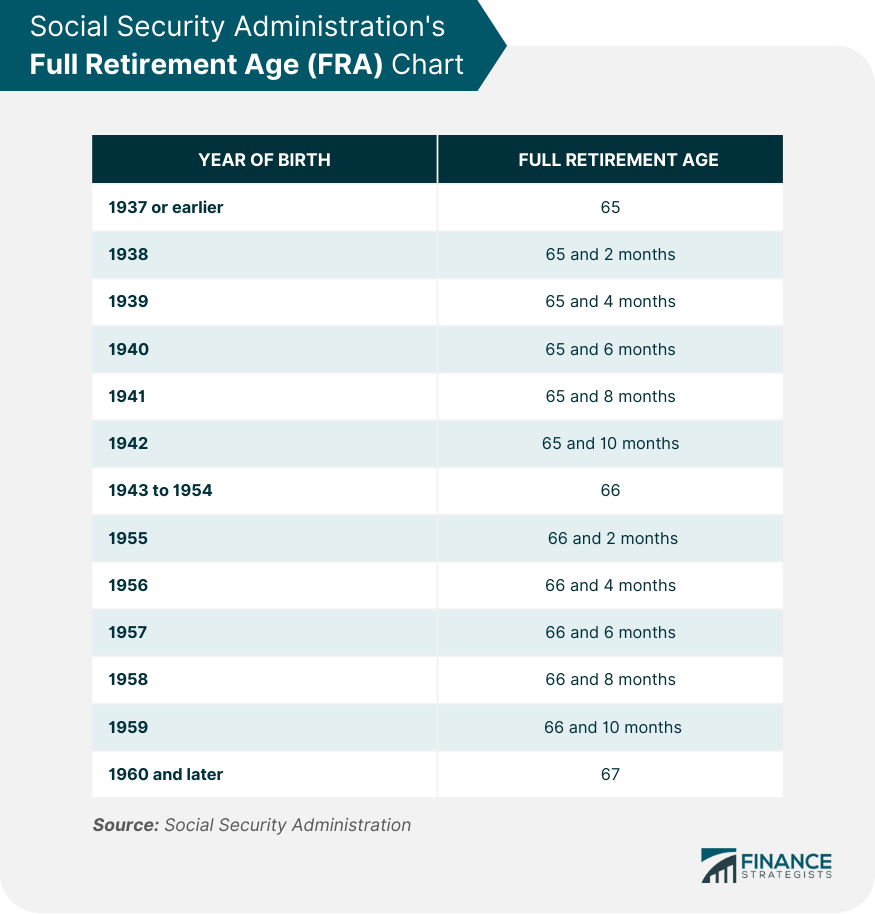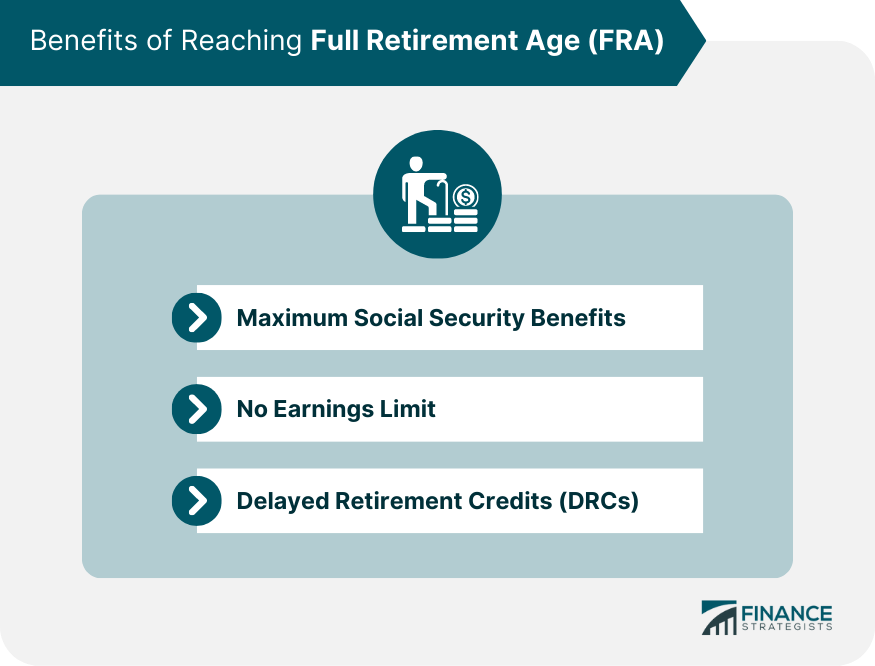Full Retirement Age (FRA), also known as "normal retirement age," is when an individual becomes eligible to receive full, unreduced Social Security retirement benefits. FRA is determined by the Social Security Administration (SSA) and is based on an individual's birth year. FRA is an important concept in retirement planning because it affects the amount of Social Security benefits an individual can receive.
I'm Taylor Kovar, a Certified Financial Planner (CFP), specializing in helping business owners with strategic financial planning. Maximize your Full Retirement Age (FRA) benefits by delaying Social Security claims until you reach FRA or beyond, up to age 70, to increase your monthly benefits. Consider your health, life expectancy, and financial needs to determine the optimal time to start receiving benefits. Regularly review your retirement plan to adjust for changes in your financial situation. Ready to secure your financial future? Start planning today to make the most of your retirement years. Contact me at (936) 899 - 5629 or [email protected] to discuss how we can achieve your financial objectives. WHY WE RECOMMEND: IDEAL CLIENTS: Business Owners, Executives & Medical Professionals FOCUS: Strategic Planning, Alternative Investments, Stock Options & Wealth PreservationWhat Is Full Retirement Age (FRA)?
Claiming Social Security benefits before reaching FRA results in a permanent reduction in the monthly benefit amount, while delaying benefits beyond FRA can result in an increase in the monthly benefit amount due to Delayed Retirement Credits.Learn From Taylor

Fee-Only Financial Advisor
Certified Financial Planner™
3x Investopedia Top 100 Advisor
Author of The 5 Money Personalities & Keynote Speaker
Historical Background of Full Retirement Age
Social Security Act of 1935
The concept of the Full Retirement Age originated with the Social Security Act of 1935, which established the United States social insurance program. The act set the FRA at 65 years for most workers, as it was considered a reasonable age to retire and receive full benefits.
Evolution of FRA in the United States
Over time, the FRA has been adjusted in response to changes in life expectancy and the financial stability of the Social Security system. The 1983 Social Security Amendments gradually increased the FRA to 67 years for individuals born in 1960 or later.
International Comparison of FRA
FRA varies across different countries, with most developed countries having an FRA between 65 and 67 years. Some countries have implemented gradual increases in their FRA, similar to the United States, to address demographic changes and the sustainability of their pension systems.
Determining Your Full Retirement Age
Birth Year as a Determinant
Your birth year is the primary determinant of your FRA. The Social Security Administration provides a chart that lists the FRA based on birth year, making it simple to find your FRA.
Social Security Administration's FRA Chart
The FRA chart provides a clear breakdown of the FRA based on birth year, which ranges from 65 to 67 years. Below is a table summarizing the different FRAs based on birth year.

Impact of Changes in Life Expectancy on FRA
As life expectancy increases, future policy changes may further adjust the FRA. These adjustments aim to maintain the financial sustainability of the Social Security system and reflect the changing retirement landscape.
Benefits of Reaching Full Retirement Age
Maximum Social Security Benefits
Maximum Social Security benefits refer to the full, unreduced monthly benefit amount an individual can receive based on their earnings record. Reaching one's Full Retirement Age is a key milestone in achieving these maximum benefits.
By waiting until FRA to claim Social Security benefits, individuals can ensure they receive their full benefit amount, known as the Primary Insurance Amount (PIA), without any permanent reductions.
The PIA is calculated using a formula that accounts for an individual's highest 35 years of earnings and represents the highest monthly benefit they are entitled to at FRA.
In contrast, individuals who choose to claim Social Security benefits before reaching their FRA will experience a permanent reduction in their monthly benefit amount.
This reduction is based on the number of months they claim benefits before their FRA, and it can significantly impact their retirement income.
Therefore, understanding one's FRA and the implications of claiming benefits early or at FRA is essential for making informed decisions about retirement planning and maximizing Social Security benefits.
No Earnings Limit
The Social Security Administration imposes an earnings limit on individuals who claim Social Security benefits before reaching their Full Retirement Age.
This earnings limit, also known as the retirement earnings test, restricts the amount of income an individual can earn from work without affecting their Social Security benefits.
If an individual's earnings exceed the annual limit, their Social Security benefits may be temporarily reduced. The earnings limit is adjusted annually and varies depending on whether the individual is below FRA, in the year they reach FRA, or has already reached FRA.
However, once an individual reaches their FRA, the earnings limit no longer applies. This means that individuals who have attained their FRA can continue to work and earn income without any impact on their Social Security benefits.
They can receive their full Social Security benefit amount regardless of how much they earn from employment or self-employment. This flexibility allows individuals to supplement their retirement income and maintain financial security while continuing to work, if they choose to do so.
The absence of an earnings limit at FRA gives retirees greater freedom to balance work and retirement according to their individual needs and preferences.
Delayed Retirement Credits (DRCs)
Delayed Retirement Credits (DRCs) are a financial incentive offered by the Social Security Administration to encourage individuals to postpone claiming Social Security retirement benefits beyond their Full Retirement Age.
DRCs are earned each month that an individual delays claiming benefits after reaching their FRA up until 70. The accumulation of DRCs permanently increases the individual's monthly Social Security benefit amount, leading to higher retirement income.
The percentage increase in benefits due to DRCs varies depending on the individual's birth year. The longer the delay, the greater the increase, up to the maximum at age 70.
This financial incentive can be especially beneficial for individuals who are in good health, have a longer life expectancy, and wish to maximize their lifetime Social Security benefits.
By understanding the impact of DRCs, individuals can make informed decisions about when to claim benefits and optimize their retirement income.

Early Retirement vs Full Retirement Age
Early Retirement Eligibility
You can choose to retire early and start receiving Social Security benefits as early as age 62. However, this comes with certain consequences.
Reduction in Social Security Benefits
If you retire early, your Social Security benefits will be permanently reduced. The reduction depends on how many months before your FRA you start receiving benefits.
Factors to Consider for Early Retirement
When considering early retirement, weighing the reduced benefits against factors such as your health, life expectancy, financial needs, and personal preferences is essential. Carefully evaluating these factors will help you make an informed decision about early retirement.
Delaying Retirement Beyond Full Retirement Age
Increased Monthly Benefits
You can increase your monthly Social Security benefits by delaying retirement beyond your FRA. This is due to the accumulation of Delayed Retirement Credits.
Earning Delayed Retirement Credits
For every year you delay retirement beyond your FRA, your Social Security benefits increase by a certain percentage up to age 70. This can result in a significantly higher monthly benefit.
Factors to Consider for Delayed Retirement
When considering delayed retirement, evaluating your financial needs, life expectancy, health, and personal preferences is important. Delaying retirement may not be suitable for everyone, so making a decision that aligns with your circumstances is essential.
Planning for Retirement With Full Retirement Age in Mind
Calculating Your Retirement Needs
Understanding your FRA can help you better calculate your retirement needs. This includes estimating your expected Social Security benefits and considering other sources of retirement income and expenses.
Savings and Investment Strategies
Your FRA should be a factor in your overall savings and investment strategies. This can help ensure you have enough financial resources to support your desired retirement lifestyle.
Factoring in Health Care and Long-Term Care Costs
Health care and long-term care costs can be significant expenses during retirement. Your FRA may impact your ability to cover these costs, so it is crucial to plan for them in your retirement planning.
Conclusion
Understanding the Full Retirement Age (FRA) is crucial for effective retirement planning and optimizing Social Security benefits. FRA is the age at which individuals become eligible to receive full, unreduced Social Security retirement benefits.
Reaching FRA has several benefits, including the ability to receive maximum Social Security benefits without any permanent reductions.
Additionally, individuals who reach FRA can continue to work and earn income without any earnings limit impacting their Social Security benefits, providing flexibility in retirement decisions.
Delaying retirement beyond FRA can result in increased monthly benefits due to Delayed Retirement Credits, which can significantly enhance retirement income. However, claiming benefits before FRA leads to a permanent reduction in the monthly benefit amount. |
It is important to carefully evaluate the factors associated with early retirement or delaying retirement, such as health, life expectancy, financial needs, and personal preferences.
Considering FRA in retirement calculations, savings and investment strategies, and planning for healthcare costs are essential for a well-rounded retirement plan.
By understanding the benefits and implications of FRA, individuals can make informed decisions to secure a comfortable and financially stable retirement.
Full Retirement Age (FRA) FAQs
Full Retirement Age (FRA) is when an individual becomes eligible to receive full, unreduced Social Security retirement benefits. FRA is important because it affects the amount of Social Security benefits a person receives, with reduced benefits for claiming early and increased benefits for delaying beyond FRA.
Your Full Retirement Age (FRA) is determined by the Social Security Administration (SSA) based on your birth year. For individuals born in 1937 or earlier, the FRA is 65. For those born between 1938 and 1959, the FRA gradually increases from 65 to 67. For individuals born in 1960 or later, the FRA is 67.
Yes, you can claim Social Security retirement benefits as early as age 62, regardless of your Full Retirement Age (FRA). However, claiming benefits before FRA results in a permanent reduction in your monthly benefit amount. The earlier you claim, the greater the reduction.
If you delay claiming Social Security benefits beyond your Full Retirement Age (FRA), you can earn Delayed Retirement Credits, which increase your monthly benefit amount. These credits accrue until age 70, after which there is no additional increase for delaying benefits.
You can find out your specific Full Retirement Age (FRA) by using the retirement age calculator provided by the Social Security Administration (SSA) on its website. The calculator allows you to input your birth year and determine your FRA based on SSA guidelines.
True Tamplin is a published author, public speaker, CEO of UpDigital, and founder of Finance Strategists.
True is a Certified Educator in Personal Finance (CEPF®), author of The Handy Financial Ratios Guide, a member of the Society for Advancing Business Editing and Writing, contributes to his financial education site, Finance Strategists, and has spoken to various financial communities such as the CFA Institute, as well as university students like his Alma mater, Biola University, where he received a bachelor of science in business and data analytics.
To learn more about True, visit his personal website or view his author profiles on Amazon, Nasdaq and Forbes.













